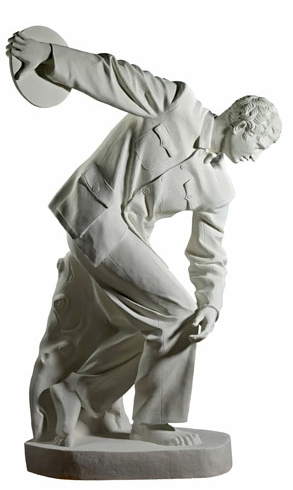
The Discobolus (discus thrower) is one of the most famous sculptures from the ancient world and has come to mean different things to different people. This display at the British Museum features contemporary Chinese artist Sui Jianguo’s beautiful and thought-provoking interpretation from June 1st through to September 9th, 2012.
The famous marble Discobolus statue is one of the British Museum’s best known objects. It is one of many copies made by the Romans of a Greek bronze original, cast around 450 BC by Myron of Athens. The original has long been lost. The Museum’s marble copy, known as the ‘Townley Discobolus’, was excavated at Hadrian’s Villa near Rome in 1791 and can be seen on display in the Great Court.
After the Townley Discobolus’ discovery, it inspired 18th- and 19th-century artists and sculptors who were part of a wider Greek Revival in art and architecture. Another Roman marble copy featured in the 1936 film of the Berlin Olympics by Leni Riefenstahl; two years later it was bought by the Nazis and became a symbol of their ideas of the master race. In 1948, the Olympic Games were held in Britain. The London Transport poster featured the Townley Discobolus as a symbol of freedom and democracy – a concept traditionally associated in the West with ancient Greece.
'I wanted to show how through self-reflection I have come to throw off the bonds of the education I received at the Art Academy and its socialist ideology. Instead of these I have created a ‘way of art’ all my own.' Sui Jianguo
The power of the Discobolus as a cultural icon continues today with Chinese sculptor Sui Jianguo’s (b. 1956) clothed version, on display in Room 3.
The display of the Townley Discobolus and Sui Jianguo’s response so close to each other allows us to see the conversation(s) between ancient and modern, and East and West.
Courtesy of Sui Jianguo and the British Museum, for further information please visit Sui Jianguo’s discus thrower.




























